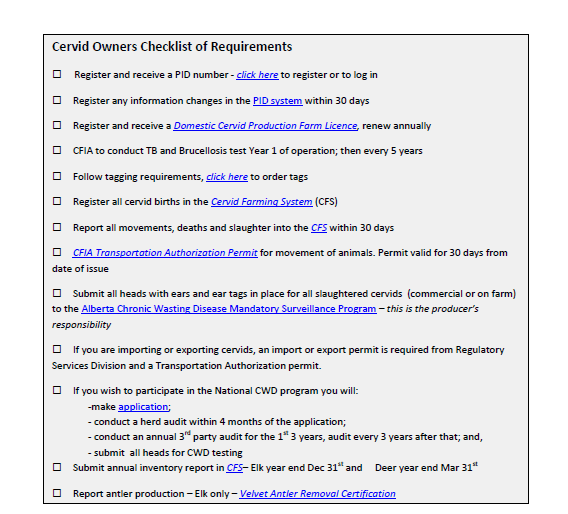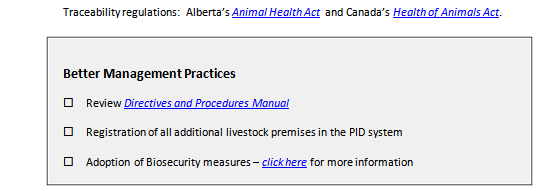| | Premises Identification | Animal Identification | Animal Movement | Traceability Home
.
| Traceability is a crucial component of an effective animal health and food safety system that enables precise and rapid emergency response to protect livestock, producers and consumers. Determining where livestock are, where they have been and what other livestock they have come into contact with allows for efficient emergency planning and response. Traceability in Alberta relies on the three fundamental pillars of premises identification, animal identification and animal movement. |
Click here to print this checklist


Premises Identification
Premises Identification (PID), one of the three traceability pillars, is a way of linking livestock and poultry to land locations. The information collected through the Alberta Agriculture and Forestry (AF) Premises Identification System allows industry and government to locate animals more quickly and accurately to confine a disease outbreak or emergency such as a flood or fire. Animal owners can be notified if an emergency might affect their animals and operation but this can only be accomplished if land locations are registered in the Premises Identification System.
Under Alberta’s Premises Identification Regulation, if you own a livestock animal or poultry, and that animal is kept at a premises other than a commingling site (e.g. stable), you need to apply for a PID Account and obtain at least one PID Number associated to where the animal(s) are located. You must apply for a PID Account within 30 days of assuming ownership of an animal. If you own an animal that is only kept at locations controlled by someone else (e.g. stable) and that animal will never be kept at a premises under your care and control (e.g. farm or acreage), you are not required to register for a PID Account. However, you will need to obtain the PID Number from the operator of the site.
Although only the primary agricultural operation (e.g. home quarter) needs to be registered in the PID System, registering other locations that are not connected to the home quarter will ensure that your operation is better protected. Although you may view your livestock as a pet or companion animal, it is important to obtain a PID Account because your animal can still receive and/or transmit diseases. To find out the species of animals included under the regulation, click here. Even if you only own one animal, it is still necessary to obtain a PID Account.
If you operate a commingling site (e.g. stable, community pasture, fair ground, etc.), you are required to obtain a PID Account, register all your commingling sites and provide the PID Number(s) to the users of your site(s). You must apply for a PID Account within 30 days of assuming ownership or operation of a commingling site.
How to apply and update your account
| To apply for a PID Account or to access/update it online: | Click here |
| To apply for a PID Account or to update it by paper application:
(PID paper application forms are also available at AF Field Offices located throughout Alberta.) | Click here |
Registering your premises is one of the best ways to safeguard your animals and it’s free. It is important that you keep your information up to date and you must report account changes within 30 days. For example, this would include changes in account contact information, maximum capacity of the premises and contact information for emergencies. If the PID System does not contain accurate and up-to-date information, the emergency response might be delayed.
Animal owners will need to have a PID Number to:
- Buy medication for your animals at retail outlets (this requirement took effect on July 1, 2014 as part of amendments to the Animal Health Act)
- Complete movement documents such as manifest and permits, if required, when transporting your animals.
- Sell livestock at auction markets
- Apply for many government sponsored agriculture grants and programs
For additional information on the PID Program:
Important note: Information must be kept up to date so that you can be contacted quickly in the event of an emergency.
Animal Identification
The Cervid Industry Traceability Initiative (CITI) has been undertaken by the Canadian Cervid Alliance to access the current needs of the farmed cervid industry for traceability tools and systems to assess the capabilities of currents systems and develop a National Strategy and Action Plan.
In Alberta, you are required to tag all cervids with approved tags in accordance to regulation and outlined in the Domestic Cervid Directives and Procedures Manual and follow all reporting requirements.
Animal Movement
Prior to shipping animals, you must apply for and receive a Transportation Authorization Permit from CFIA.
| As an important member of the cervid industry, you play a key role in the traceability system for livestock in Alberta and Canada. Accurate and current information supporting premises identification, animal identification and movement is crucial to a robust traceability system. Please take care to ensure that information associated with your animals is accurate and that information supporting traceability is documented. |
Traceability Home |
|